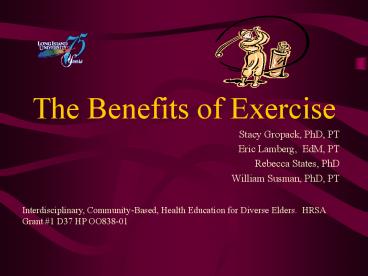The Benefits of Exercise - PowerPoint PPT Presentation
1 / 16
Title:
The Benefits of Exercise
Description:
What are the Benefits of Exercise? ... How Do You Get Started With An Exercise Program ... Exercise primarily for your neuromuscular system (nerves, brain and muscles) ... – PowerPoint PPT presentation
Number of Views:774
Avg rating:3.0/5.0
Title: The Benefits of Exercise
1
The Benefits of Exercise
Stacy Gropack, PhD, PT Eric Lamberg, EdM,
PT Rebecca States, PhD William Susman, PhD, PT
Interdisciplinary, Community-Based, Health
Education for Diverse Elders. HRSA Grant 1 D37
HP OO838-01
2
Physical Activity
- Any voluntary body
- movement that burns calories (expends energy)
3
Exercise
- A subcategory of physical activity
- Is planned, structured and repetitive
- Results in improvement or maintenance of on or
more facets of physical fitness - Endurance
- Strength
- Flexibility
- Coordination
4
What are the Benefits of Exercise???
- Reduces the risk of developing chronic diseases
such as heart disease. - Aids in the management of active problems such as
high blood pressure, diabetes, obesity, or high
cholesterol. - Improves the ability to function and stay
independent in the face of active problems like
lung disease or arthritis.
5
Benefits of Exercise
- Research has also proven that exercise
- Lowers risk of obesity.
- Improves mood and relieves symptoms of
depression. - Improves quality of life, general well being and
everyday functioning. - Improves function in persons with arthritis.
- Lowers risk of falls and injury
- Improves sleep
- Prevents bone loss
6
Consult with your doctor or rehabilitation
professionalYou Should Not Exercise If You Have
- Chest pain
- Irregular heart rate
- Severe shortness of breath
- Unexplained weight loss
- Blood clot
- Foot or ankle sores that will not heal
- Swelling of the joints
- Persistent pain after a fall
- After surgical procedures
7
How Do You Get Started With An Exercise Program
- Check with a doctor or a rehabilitation
professional if necessary - Choose an activity you enjoy
- Choose an activity that fits you socially and
financially - Choose activities that are easily accessible
- Make a regular schedule for exercise and try to
stick to it
8
Types of Exercise
- Endurance
- Strength
- Flexibility
- Coordination
9
Endurance Exercise
- Exercise for your cardiopulmonary (heart and
lungs) system - They are activities that increase your heart rate
and breathing for an extended period of time in a
healthy way.
10
Examples of Endurance Exercises
- Walking
- Swimming
- Bicycling
- Dancing
- Cleaning
- Climbing the stairs
11
Strength and Flexibility Exercise
- Exercise for you musculoskeletal (muscles and
bones) system - These exercises help increase or maintain your
strength and keep you loose and flexible.
12
Examples of Strength and Flexibility Exercises
- Moving any part of your body against gravity in a
sequenced pattern and with appropriate timing - Using hand held weights or ankle weights when
appropriate - Doing activities of daily living repetitively or
with resistance (increase loads) - Stretching tight muscles
13
Balance and Coordination Exercises
- Exercise primarily for your neuromuscular system
(nerves, brain and muscles) - Help prevent frequent falls and loss of balance
- Allow your movements to be more fluid and smooth
14
Examples of Balance and Coordination Exercises
and Activities
- Sports such as tennis, golf and softball
- Playing ball with the kids and grand kids
- Practicing standing on one foot (use support if
you need it) - Walking a straight line (one foot in front of the
other)
15
Activities
- Lets Get Moving
- It Is Time To Exercise
16
(No Transcript)































